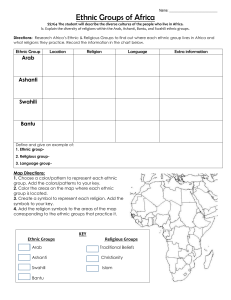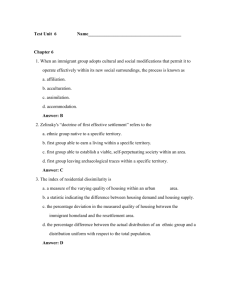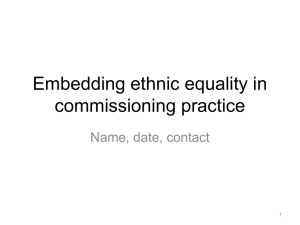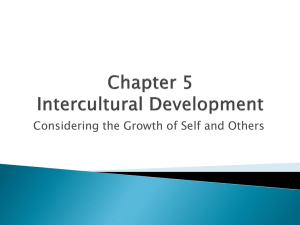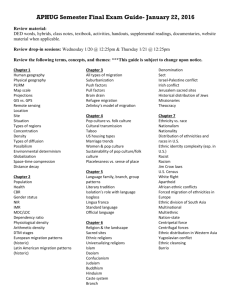AP Human Geography Study Guide Chapter 6: ETHNIC
advertisement
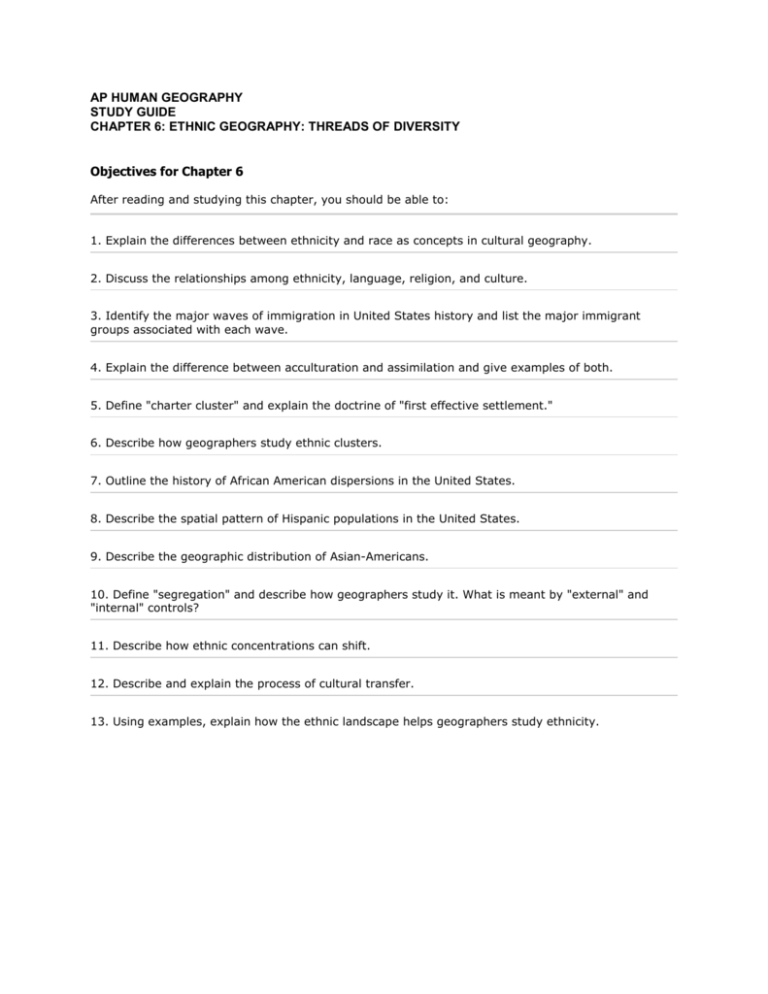
AP HUMAN GEOGRAPHY STUDY GUIDE CHAPTER 6: ETHNIC GEOGRAPHY: THREADS OF DIVERSITY Objectives for Chapter 6 After reading and studying this chapter, you should be able to: 1. Explain the differences between ethnicity and race as concepts in cultural geography. 2. Discuss the relationships among ethnicity, language, religion, and culture. 3. Identify the major waves of immigration in United States history and list the major immigrant groups associated with each wave. 4. Explain the difference between acculturation and assimilation and give examples of both. 5. Define "charter cluster" and explain the doctrine of "first effective settlement." 6. Describe how geographers study ethnic clusters. 7. Outline the history of African American dispersions in the United States. 8. Describe the spatial pattern of Hispanic populations in the United States. 9. Describe the geographic distribution of Asian-Americans. 10. Define "segregation" and describe how geographers study it. What is meant by "external" and "internal" controls? 11. Describe how ethnic concentrations can shift. 12. Describe and explain the process of cultural transfer. 13. Using examples, explain how the ethnic landscape helps geographers study ethnicity. OVERVIEW 1. Ethnic geography studies the spatial distributions and interactions of ethnic groups—populations distinguished by common origins and distinctive cultural or racial traits. Ethnicity is a spatial concept; recognized homeland areas, urban enclaves, or rural settlement districts are the rule. 2. Most societies are multiethnic, with ethnic mixing increasingly common in response to migration and refugee flows into even formerly homogeneous societies and countries. Ethnocentrism is a feeling of one's own ethnic group superiority that tends to encourage isolation and to inhibit the amalgamation of complex societies. 3. Ethnic distinctions may be based either on cultural or racial characteristics. The former involves acquired traits, the latter genetic differences. Genetic drift and adaptation may create distinctive heritable traits among separate populations as populations adjust to their physical environments. Those traits have nothing to do with language, religion, nationality, or other acquired characteristics. 4. Some societies, such as the Anglo American, are the product of multiethnic immigration and mixing. The origin areas of U.S. immigrant flows have changed from earlier European and African homelands to a recent strong prominence of Asian and Latin American nationals. 5. The merger of different ethnic groups into a single social structure, if it occurs at all, may involve amalgamation—the creation of a composite mainstream society with merged characteristics—or acculturation—adoption by new immigrant groups of the values and norms of a dominating host culture or charter group. When integration is complete, assimilation has occurred. Amalgamation Theory, the idea of a melting pot, has recently fallen out of favor with some scholars as being unrealistic due to cultural tensions that exist in many societies. The gene pool also acts as a hindering factor to amalgamation. 6. Except for French Canadians and some Native Americans, Anglo America has no defined ethnic homeland areas. However, immigrant streams have created recognizable spatial ethnic patterns. Ethnic provinces include larger racial or cultural concentrations, including those of French Canadians in Quebec, African Americans in the U.S. Southeast, Native Americans in the Southwest, the northern plains and Prairie Provinces, and in Northern Canada and Alaska, and Hispanics along the borderlands of the Southwest. Ethnic islands reflect both rural and urban cluster and chain migration and take the form of distinctive rural landscapes and pronounced urban immigrant neighborhoods. 7. The immigrant neighborhood is evidence of social distance between immigrant and charter groups, which is partially determined by the existence and effectiveness of internal and external controls. It may reflect either self-elected defensive refuge or imposed segregation. When self-created and maintained, the ethnic community can ease the entry of new arrivals into mainstream society. When imposed by the majority group, the immigrant or racial ghetto perpetuates discord and separation. 8. Cultural geographers are interested in landscape evidence of ethnicity. It may take such variant forms as differing house or building styles, settlement patterns, land survey systems, or styles and manners of dress and customary behavior. In all world regions, including Anglo America, such landscape contrasts help document the essential spatial aspect of ethnicity. EXPANDED KEY WORDS LIST acculturation adaptation amalgamation theory assimilation behavioral (cultural) assimilation chain migration charter group classic northern ghetto classic southern ghetto cluster migration colony competition theory culture culture rebound early northern ghetto early southern ghetto ethnic cleansing ethnic enclave ethnic geography ethnic group ethnic island ethnic province ethnicity ethnocentrism first effective settlement gene flow genetic drift ghetto guest worker homelands host society immigrant index of residential dissimilarity long lot melting pot Mestizo metes-and-bounds nationalism natural selection race rectangular survey segregation social distance structural assimilation tipping poin Chapter 6 Assignments (all submissions must be typed) Assignment #1 - Read pp. 165 - 173, and respond to the following: Due On Tuesday 3/3 1. Define the following in the context in which they are used In the reading: Ethnic Geography Ethnic Group Ethnicity Ethnocentrism Host Society 2. Compare and contrast the terms culture and ethnicity 3. How does ethnocentrism contribute to the preservation of group Identity? 4. Define the following in the context in which they are used In the reading: natural selection adaptation genetic drift gene flow race 5. Read "The Matter of Race (p. 168.) Why is, "…social categorization…a scientifically outdated way of making sense of human variation." 6. Describe the three waves of immigration in the US and Canada. 7. Why will the US be "truly multi-racial" by 2050? 8. Why is Amalgamation theory suspect today? What factors have contributed to its downfall? 9. What is acculturation? Describe the melting pot, salad bowl and lumpy stew views of acculturation. 10. Compare and contrast behavioral and structural assimilation. Why Is structural assimilation elusive to many new immigrants? Class Activity: Ethnic Separatism Web, Wednesday __________________________________________________________________________________________ Assignment #2 - Read pp. 173 – 184 and respond to the following: Due On Thursday 3/5 1. Define 1st effective settlement and charter group In relation to Anglo America. 2. Describe the locations, and the reasons for the locations of ethnic islands in Anglo-America. 3. How do cluster migration and chain migration contribute to the formation of ethnic Islands and ethnic provinces? 4. How and why do Anglo American areal expressions of ethnicity differ from the former USSR and S. Asia? 5. Explain/Outline the following spatial ethnic patterns over time: – Black Dispersions – Hispanic Concentrations – Asian Contrasts – French Uniformity 6. Immigrant Gateways and Clusters – Identify the main U.S. immigrant gateways 7. Read Kuby 356-365 Class Activity: Kuby Ch 12, Thurs/Fri, 3/5,6 Due on Mon 3:30 __________________________________________________________________________________________ Assignment #3 - Read pp. 184 – 189 and respond to the following: 1. 2. 3. 4. 5. Due On Tuesday, 3/10 Define the terms social distance and segregation. Describe how segregation is measured using the index of residential dissimilarity. Describe the segregation patterns for Blacks, Hispanics and Asians in major U.S. urban areas. Describe the ethnic segregation patterns of world areas outside of North America. Compare and contrast those patterns to those in U.S. cities. What forces external to ethnic groups help to create and perpetuate immigrant neighborhoods (external controls)? What three functions beneficial to immigrant groups do ethnic communities provide (internal controls)? Explain how and why ethnic concentrations shift over time in urban areas. What impacts are increasing ethnic diversity and continuing immigration flow having on urban ethnic concentrations? _____________________________________________________________________________________________ Assignment #4 - Read pp.. 189-197 and respond to the following: 1. 2. 3. 4. 5. Due on Wednesday 3/11 Compare and contrast ethnic enclaves and ghettos. Compare and contrast the classic southern ghetto for newly freed Blacks with the early northern ghettos. Be sure to note the areal differences. Explain how the change in U.S. immigration law in 1965 changed the origins, as well as, areal concentrations of new immigrants. How are these new immigration patterns related to the notion of White/Native retreat (often termed “White flight?) Finally, explain why these phenomena have made assimilation more difficult. Explain the notion of cultural transfer and cite factors that impact the extent of transfer. Cite and explain examples of both internal and external rejection factors. What kinds of land surveys were important in the allocation of property in the North American Culture Realm? With which charter groups were the different survey systems allocated? How did survey systems affect settlement patterns? Thursday 3/12: Review Time/Work Time on Reading Response or Jeopardy _____________________________________________________________________________________________ Assignment #5 - Reading Response Due on Friday 3/13 Ethnic Residential Concentrations in United States Metropolitan Areas: By James P. Allen and Eugene Turner 1. 2. 3. 4. 5. 6. 7. 8. 9. What is the correlation between assimilation and residential concentration? Assimilation theory assumes that there will be some residential concentration among ethnic groups in the early stages of assimilation. Why might such concentrations be unnecessary today (heterolocalism)? How do the authors distinguish residential concentration and enclaves in their study? Why do they make this distinction? Summarize the character of ghettos, pre and post 1970. Summarize Spatial Assimilation Theory. Summarize the reasons for not expecting residential concentration. Summarize the reasons for expecting residential concentration. What type of areal unit was used for this study? Why did the authors choose this unit of measurement? How might we explain the variance in ethnic residential concentrations in the same ethnic group among specific cities? 10. What conclusions might we come to regarding immigrant residential concentrations and spatial assimilation theory as a result of this study? Possible Projects/XC 1. Using background material easily obtained on the net, detail the importance of ethnicity and ethnocentrism in the affairs of one or more foreign countries. Tamil/Sinhalese conflict in Sri Lanka, Basque demands and actions in the Pyrenees, Welsh and Scottish movements for devolution, “ethnic cleansing” in the former Yugoslavia or any of several African states, and ethnic conflict in the Middle East (Syria, Turkey, Iraq, etc.) are all possibilities. 2. Using the Census Bureau (http://www.census.gov) make a table of the primary ethnic groups in a selected city. Hypothesize and research how and when those groups came to settle in the area. Do any of the groups listed have a particular geography within the town? Is their evidence of ethnic neighborhoods and segregation? 3. Form student groups and assign each group one ethnic group and all groups a set of major US and world cities. Each group will investigate the location of residence of their respective ethnic group in the assigned cities. Compare and contrast locations in the various cities of the ethnic group. Then compare across groups looking for relationships between ethnic groups and location of their residences.



